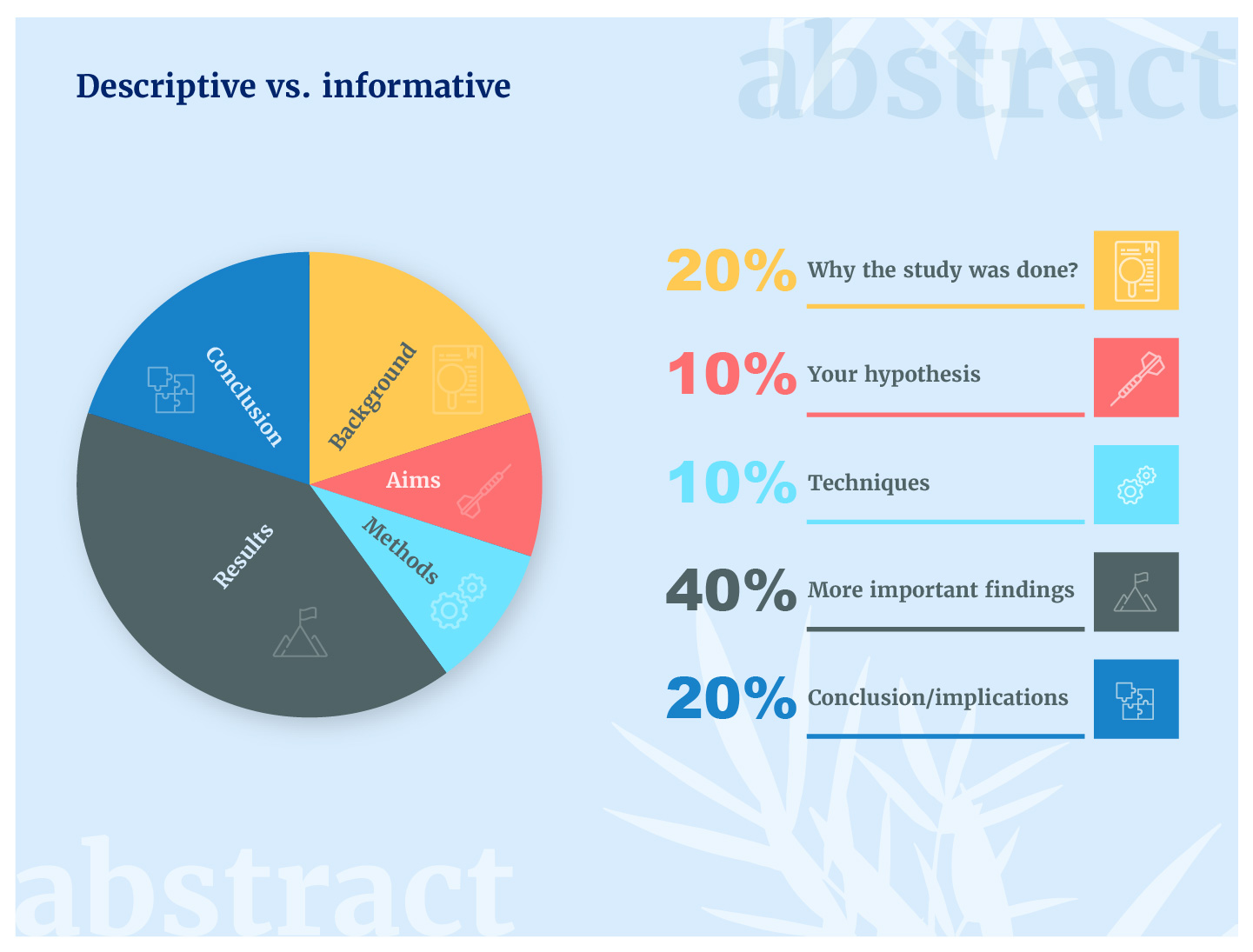An abstract is a short summary of your research manuscript, typically around 200–250 words, briefly presenting why and how you did your study, and what you found. That’s a simple definition, but the structure and style of an abstract are where there are certain rules to follow.
Even more, you’ll increase your chances of publication and of getting cited when you know what to do and not do. That’s what we’ll get into in this article.
What you’ll learn in this post
• All the basics of what goes into a research abstract for academic and scientific publication.
• What the abstract’s role is, and why it should never be overlooked or a simple repeat of text in your paper.
• The types of abstracts.
• What grammar and tense to use in an abstract.
• Expert tips on the abstract from Edanz’s science director.
• Where to get expert guidance for your abstract.
What is an abstract and why is it important?
Along with the title, the abstract is the first thing most readers will look at. It’s where they should get a clear and factual summary of your paper. This is also where readers usually decide to continue reading or to move on to something else. It’s like an elevator pitch.
The abstract should also be attractive enough to to get readers to read the entire paper. The content of the abstract, along with the title and keywords, is essential for the discoverability of your paper. This means you should prepare it carefully, revise it, and ideally have others read (and maybe edit) it to be sure it says what you intend.
We’ll also note, right from the start, that it’s best to write our abstract LAST – after you’ve written your full manuscript. Only then can it be a truly accurate description of your work. And take your time with it. We’ll dig into more details in this article.
What does an abstract look like? What’s the structure?
The length of the abstract may vary depending on the type of paper and journal requirements. Most abstracts are around 200–250 words, but they can range from 100 (for a short summary like in mathematical papers) to 300 for certain journals, like PLOS ONE.
Abstracts can be any of the following:
- Unstructured: A single paragraph with no subheadings
- Structured: Divided subsections with headings such as Objective or Background, Methods, Results, and Conclusions. Clinical journals may require additional or alternative sections, such as Patients, Interventions, or Outcomes.
We can’t tell you why. It’s just a matter of journal preference, so check the guidelines carefully.
The good news is it’s pretty easy to turn an unstructured abstract into a structured one – just add subheadings and reword a bit. Or vice versa – just take out the subheadings and make sure it’s still readable. Edit accordingly.
There are also graphical and video abstracts, which give you the chance to visually explain your work, but we’ll cover those separately.
What writing style do you use for an abstract?
First of all, an abstract should not copy-paste text from the body of the manuscript. It should paraphrase your work and then be sharpened to make it easier to read.
Past tense
Abstracts parts related to the aims, methods, and results are in the past tense. That’s because they tell what already happened – you already did the study.
Present tense
The background and conclusion are often in the present tense. That’s because they’re talking about ongoing things, like research activity and areas the study affects.
Active voice
Many journals also allow, and even encourage, use of the active voice and first-person plural pronoun (we, if there are 2 or more authors) – e.g., “We found…”
Exceptions
Abstracts for research proposals or funding applications, however, use future tense when discussing the study’s specifics. Why? That’s easy – because you haven’t done the work yet.
Journals in some disciplines have different styles. They may use the present tense throughout, especially for chemical synthesis or mathematical/computer modeling studies. They may also use passive voice throughout and not allow “We” even if these are allowed in the text of the main article.
Conference abstracts may have different styles. For example, the conference organizers may allow you to include references and small figures or tables.
References and abbreviations
Basically – no and no for references and abbreviations, but there are (always) exceptions.
Abstracts normally should not include reference citations or references to tables and figures in the main text. There’s simply no need unless your study is centered on a specific work.
Abstracts should “stand alone” – your reader should be able to understand the contents without having to refer to the rest of your paper. So…
Abbreviations should be avoided. They take up space and your readers may not understand them. Remember, an abstract isn’t only written for specialists in your field. For example, HIV is probably OK in abbreviated form. but even though RT-PCR is fine for a journal reporting molecular biology techniques, even there, it would probably need to be spelled out in the abstract.
Jargon and technical language should also be avoided whenever possible. If it’s impractical to avoid such terms, they should be defined clearly.
Descriptive vs. informative abstracts
Based on their content, abstracts can be descriptive or informative.
Abstracts of scientific papers are usually informative: that is, they include specific information related to the objective, methods, and results.
To be sure your abstract includes all the necessary information, try to answer the following questions:
- What’s the reason you did the study? (State what’s known and why the study is needed. Some journals and peer reviewers, even if they don’t overtly state it, may also reject submissions without a clear, testable hypothesis statement. It’s best to include one.)
- What did you do to fulfill the objective/prove the hypotheses?
- What were the main findings? (Make sure these are directly related to the stated objectives)
- What are the meaning, implications, and relevance of the findings?
You may recognize that abstracts follow an IMRaD format similar to the path you follow in a typical manuscript. But in the abstract, you only have space for the key methods and results. There’s no space for a real discussion, so the final section is simply the Conclusion.

Even if the abstract you’re preparing is unstructured (just one paragraph and without subheadings, but check the journal guidelines, because sometimes there’s more than one paragraph), the content should still include the same core elements as a structured abstract.
Try stating the answers to the above questions in a logical order, and you’ll be on your way to writing a complete, effective abstract. It should be possible to clearly identify the abstract’s different parts.
Some clinical journals also require additional standalone sections to highlight a particular aspect of the work. Often, this content should normally be included in any abstract anyway:
For example:
- Clinical learning point
- What we knew before / What we know now
Finally, make sure the final abstract is consistent with the main text of the manuscript in terms of data, results, and general wording. And, even though we’re repeating ourselves here, be sure it satisfies what the journal guidelines ask for!
This means: check the word count, structure, subheadings, use of abbreviations, rules about active vs. passive tense, and so on. If you need some help, ask a pro editor to proofread it. Then you can be sure you don’t miss anything.
It’s an awful shame for a great study to get rejected just because you didn’t spend a little extra time (and in some cases a little extra money) to be sure your abstract shines.

Dr. McGowan on abstracts
We asked our Chief Science Officer, Daniel McGowan, PhD CMPP, for his thoughts on abstracts.

Most readers will read an article’s Abstract to decide whether the study is relevant to them and whether the full paper should be downloaded (which may need payment).
Some journals send only the abstract of a paper to editorial staff or editorial board members to decide if the paper should be sent for peer review.
Your abstract should therefore reflect the high quality of your study and summarize its most important findings and conclusions.
Your abstract should:
- be clear, concise, and accurate
- be easily understood: avoid uncommon abbreviations and jargon; in general, use abbreviations only if the abbreviation appears three times or more after its initial definition
- be independent (stand-alone), without referring to the main text or any of the illustrations (tables or figures)
- not contain illustrations, although some journals now ask for an additional “graphical abstract”
- not contain any citations, but if they are allowed, the references are usually included within the text rather than as a footnote
- contain some keywords
You may find it useful to draft your abstract early on (a “working abstract”) as a guide for your paper’s structure and message, and then revise it at the end. Check the guidelines of your target journal for the word count, format, and style of its abstracts.
There may or may not be a heading, and there may be subheadings (such as Background, Methods, Results, and Conclusions, in a “structured abstract”) or just one or two paragraphs without subheadings (in an “unstructured abstract”).
Regardless of the format, your abstract should answer the following four questions:
- Why was this research conducted?
- What was the specific aim/objective and main approach of the study?
- What were the main findings?
- Why are these findings useful and important?
Check your target journal for special instructions—for example:
- Do different article types have different styles of abstract?
- Should non-technical language be used or a non-technical abstract also prepared?
- Is the style descriptive (topic, aim, and only a preview of the paper’s contents) or informative (including results and conclusion)?
- Are key data and statistics expected in the results?
- Should extra information (e.g., limitations or implications) be added?
- Is only passive voice or a mixture of active and passive allowed, and what tenses are expected?
So let’s look at an example.
Example of a good abstract
This is broken down into three sections that are contain the substance of the abstract.
Depending on the journal, a couple more subheadings, such as Results, may be added. Their content is still included in this example
1. Background
The placement of medical research news on a newspaper’s front page is intended to gain the public’s attention, so it is important to understand the source of the news in terms of research maturity and evidence level.
Explanation: Subheadings are used because this journal requires a structured abstract. Note that the authors have mainly used the active voice. The Background provides the reader with the major research question.
2. Methodology/Principal Findings
We searched LexisNexis to identify medical research reported on front pages of major newspapers published from January 1, 2000 to December 31, 2002. We used MEDLINE and Google Scholar to find journal articles corresponding to the research, and determined their evidence level.
Of 734 front-page medical research stories identified, 417 (57%) referred to mature research published in peer-reviewed journals. The remaining 317 stories referred to preliminary findings presented at scientific or press meetings; 144 (45%) of those stories mentioned studies that later matured (i.e. were published in journals within 3 years after news coverage). The evidence-level distribution of the 515 journal articles quoted in news stories reporting on mature research (3% level I, 21% level II, 42% level III, 4% level IV, and 31% level V) differed from that of the 170 reports of preliminary research that later matured (1%, 19%, 35%, 12%, and 33%, respectively; chi-square test, P = .0009). No news stories indicated evidence level. Fewer than 1 in 5 news stories reporting preliminary findings acknowledged the preliminary nature of their content.
Explanation: In this combined Methods/Results section, the Methods subsection is quite short and the Results subsection makes up the largest proportion of the Abstract, because the reader is most interested in what you discovered. The order of the results goes from general to specific facts, and key data are included. The verb tense is the simple past because the study and analyses have finished. However, theoretical and modeling studies often use present tense throughout the abstract.
3. Conclusions/Significance
Only 57% of front-page stories reporting on medical research are based on mature research, which tends to have a higher evidence level than research with preliminary findings. Medical research news should be clearly referenced and state the evidence level and limitations to inform the public of the maturity and quality of the source.
Explanation: The major conclusion should be the first thing presented in this section. Here, the journal requires that the implications of the findings are also stated.
A final note from Dr. McGowan
If you keep the above tips in mind, you can write an effective abstract that will attract more readers (and journal editors!) to your research. Good luck!

Keywords
Abstracts are usually followed by a list of keywords (or “key words”) that you, as the author, will choose. These shouldn’t be an afterthought – they serve a valuable function in helping your publication get indexed, especially on Google Scholar and Google itself.
That, in turn, helps potential readers find your work, read it, and maybe even refer to it or cite it.
Keywords supplement the title; they don’t replace it. So choosing them can actually be quite hard.
Always check your target journal’s instructions for authors as often journals will specify that terms used in the title shouldn’t be used as keywords.
Journals’ instructions for authors will state how many keywords are required and may even provide a list of recommended ones. Some clinical journals, for standardization, require you to choose from Medical Subject Heading (MeSH) keywords.
Excellent choices for keywords are:
- The main theme (of course, but in slightly different wording from the title if necessary)
- An odd or quirky area of your field; i.e., a specific niche term
- Regions and/or climactic conditions
- Applications of the research
- Techniques of the research
Another perspective: Four key questions for your abstract
That’s plenty of info already. Here’s a bit more if you want a simple way to look at writing your abstract.
All good abstracts answer four questions.
- Why did you do the study?
- What did you do?
- What did you find? and…
- What did you conclude? What’s the significance of the study?
This video from our publication expert explains this in greater detail:
Graphical abstracts
A graphical abstract is a single visual summary of the main findings of the article. This can be a figure from the article or a new, specially designed figure.
Some journals request that authors provide a graphical abstract in addition to the traditional written abstract. In most cases, submission of a graphical abstract is optional; But in the future it may become a preferred style for abstracts because readers can understand the important message of the paper quickly.
The following sites provide some excellent examples of graphical abstracts in different fields of study:
Have an expert guide your abstract writing
What we call Abstract Development is one of our longest-running and most-popular author guidance services. Within as little as a day, you can hire an Edanz academic expert to write you, an abstract that accurately conveys your work in clear, accessible English. Explore Abstract Development and other services here.




